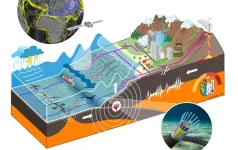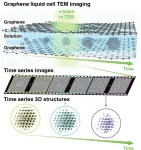(Press-News.org) One limitation of producing biofuel is that the alcohol created by fermentation is toxic to the microbes that produce it.
Now scientists are closer to overcoming this obstacle.
Researchers from the University of Cincinnati and the U.S. Department of Energy’s Oak Ridge National Laboratory achieved a breakthrough in understanding the vulnerability of microbes to the alcohols they produce during fermentation of plant biomass.
With the national lab’s neutron scattering and simulation equipment, the team analyzed fermentation of the biofuel butanol, an energy-packed alcohol that also can be used as a solvent or chemical feedstock.
Butanol is toxic to the very microorganisms that produce it. This toxicity limits the amount of butanol that can be generated during fermentation, presenting a challenge to bio-based production, said Jonathan Nickels, an associate professor of chemical and environmental engineering in UC’s College of Engineering and Applied Science.
“The primary location of toxicity is in the membrane,” Nickels said. “Ultimately, the solvent thins it out and makes it softer and less stable. Ultimately, you get holes in the membrane. When this happens, the cell loses the ability to generate energy.”
They shared their results in the journal Langmuir.
Lead author Luoxi Tan, a doctoral graduate of UC’s College of Engineering and Applied Science, is now a postdoctoral researcher at the national laboratory. He said researchers next will look to see if they can make biofuel more efficiently by stabilizing the membranes of the cells in the biomass.
Researchers investigated the processes occurring during fermentation using neutron scattering experiments that allow for non-destructive testing of the membrane, letting scientists see the structures and arrangements of molecules.
“Neutrons give you the ability to probe the interior of the membrane to help determine how the butanol is distributed,” said Hugh O’Neill, director of the Center for Structural Molecular Biology at Oak Ridge.
Researchers used supercomputers to perform molecular dynamics simulations to examine how atoms and molecules move and interact over time.
Nickels said these tools allowed researchers to see what’s happening to the structure of a cell’s membrane at the molecular level.
“The findings have very relevant and meaningful long-term implications,” Nickels said. “We want to make biofuels more efficient, which would have significant economic outcomes.”
The project was funded by the national lab’s Center for Structural Molecular Biology.
END
Researchers see breakthrough with biofuel
UC, national lab examine how alcohol damages microbes that produce it
2025-03-04
ELSE PRESS RELEASES FROM THIS DATE:
White blood cells use brute force to dislodge bacteria
2025-03-04
A vivid new image is taking shape in the world of cell biology: Imagine bacteria adhering to the surface of a cell, perhaps at the site of an injury or wound. In response, a white blood cell arrives at the scene. This cell encircles the pathogen with its membrane, forming a tight, constricting ring. With remarkable force, the white blood cell yanks the pathogen off the wound’s surface. The white blood cell then engulfs the pathogen in a process called phagocytosis, in which it “eats” the foreign invader to neutralize it.
This dramatic process might sound like something out of a science fiction story.
“But it’s precisely what ...
Foundation AI model predicts postoperative risks from clinical notes
2025-03-04
Millions of Americans undergo surgery each year. After surgery, preventing complications like pneumonia, blood clots and infections can be the difference between a successful recovery and a prolonged, painful hospital stay – or worse. More than 10% of surgical patients experience such complications, which can lead to longer stays in the intensive care unit (ICU), higher mortality rates and increased health care costs. Early identification of at-risk patients is crucial, but predicting these risks accurately remains ...
Brain functional networks adapt in response to surgery and Botox for facial palsy
2025-03-04
March 4, 2025 — For patients undergoing nerve transfer surgery for facial palsy, Botox injections can improve facial symmetry by reducing overactivity of the muscles on the unaffected side, suggests a study in the March issue of Plastic and Reconstructive Surgery®, the official medical journal of the American Society of Plastic Surgeons (ASPS). The journal is published in the Lippincott portfolio by Wolters Kluwer.
The added benefit of Botox reflects modifications ...
Multimodal AI tool supports ecological applications
2025-03-04
By Shawn Ballard
Ever seen an image of an animal and wondered, “What is that?” TaxaBind, a new tool developed by computer scientists in the McKelvey School of Engineering at Washington University in St. Louis, can sate that curiosity and more.
TaxaBind addresses the need for more robust and unified approaches to ecological problems by combining multiple models to perform species classification (what kind of bear is this?), distribution mapping (where are the cardinals?), and other tasks related to ecology. The tool can also be used as a starting point for larger studies related to ecological modeling, which scientists might use to predict shifts in plant and animal populations, ...
New University of Minnesota research shows impact of anxiety and apathy on decision-making
2025-03-04
MINNEAPOLIS/ST. PAUL (3/04/2025) — Making decisions in uncertain situations is part of daily life. New research from the University of Minnesota Medical School has uncovered that anxiety and apathy — two common but distinct emotional states — lead to fundamentally different patterns in how people learn and make decisions.
The findings were recently published in Biological Psychiatry: Cognitive Neuroscience and Neuroimaging.
The study investigated how anxiety and apathy — or a lack of interest and ...
Fred Hutch announces 10 recipients of the 2025 Harold M. Weintraub Graduate Student Award
2025-03-04
Fred Hutch Cancer Center announced 10 recipients of the annual Harold M. Weintraub Graduate Student Award, which recognizes the exceptional achievements of graduate studies in the biological sciences.
This year’s recipients represent both national and international research institutions, with a variety of thesis topics including the structural organization of neural networks, a hereditary basis for metastatic breast cancer, gene editing tools for neurodegenerative diseases and the brain’s ability to control the tongue.
“We congratulate the impressive group of domestic and international applicants this year ...
30 million euros for a novel method of monitoring the world's oceans and coastal regions using telecommunications cables
2025-03-04
Summary
The worldwide network of telecommunications cables lying on the bottom of the world's oceans offers unique potential for scientific use if the fibre-optic cables themselves are used as or equipped with sensors. Based on this, the GFZ Helmholtz Centre for Geosciences in Potsdam and the GEOMAR Helmholtz Centre for Ocean Research Kiel are now setting up the research infrastructure SAFAtor (SMART Cables And Fiber-optic Sensing Amphibious Demonstrator), that can be used to monitor the world's oceans. It will be included in the portfolio of the major Helmholtz infrastructures and funded by ...
New multicenter study shows: Which treatment helps best with high-risk acute pulmonary embolism
2025-03-04
A current study involving the University Hospital Bonn (UKB) has investigated which treatment strategy offers the best chances of survival in high-risk acute pulmonary embolism. The results, now published in the renowned journal "Intensive Care Medicine", provide crucial information for the future treatment of this life-threatening disease.
High-risk acute pulmonary embolism affects around five percent of all pulmonary embolisms and can take a dramatic course even in young people. Acute obstruction of the pulmonary circulation by a blood clot can lead to circulatory failure with a high mortality rate. The study, which was carried out in collaboration with 34 European centers ...
Hidden dangers and myths: What you need to know about HPV and cancer
2025-03-04
COLUMBUS, Ohio – While the human papillomavirus (HPV) is most associated with cervical cancer risk and women, a new survey commissioned by The Ohio State University Comprehensive Cancer Center – Arthur G. James Cancer Hospital and Richard J. Solove Research Institute (OSUCCC – James) shows that the majority of people are unaware that the virus is actually more common among men than women and is associated with rising rates of other cancers that directly impact men.
The consumer survey sought to understand the public’s knowledge of the lesser known but common virus – specifically how it is spread and its impact on cancer risk.
Survey ...
SNU researchers develop world’s first technology to observe atomic structural changes of nanoparticles in 3D
2025-03-04
Seoul National University College of Engineering announced that Professor Jungwon Park’s research team from the Department of Chemical and Biological Engineering has developed a groundbreaking technology to observe atomic structural changes of nanoparticles in three dimensions.
This study, recognized as a revolutionary achievement that resolves a long-standing challenge even past Nobel laureates could not solve, was published online in Nature Communications, one of the most prestigious international journals, on January 29.
Recently, nanoparticles have garnered significant attention as they are widely used in developing functional materials for cutting-edge industries ...
LAST 30 PRESS RELEASES:
New expert guidance urges caution before surgery for patients with treatment-resistant constipation
Solar hydrogen can now be produced efficiently without the scarce metal platinum
Sleeping in on weekends may help boost teens’ mental health
Study: Teens use cellphones for an hour a day at school
After more than two years of war, Palestinian children are hungry, denied education and “like the living dead”
The untold story of life with Prader-Willi syndrome - according to the siblings who live it
How the parasite that ‘gave up sex’ found more hosts – and why its victory won’t last
When is it time to jump? The boiling frog problem of AI use in physics education
Twitter data reveals partisan divide in understanding why pollen season's getting worse
AI is quick but risky for updating old software
Revolutionizing biosecurity: new multi-omics framework to transform invasive species management
From ancient herb to modern medicine: new review unveils the multi-targeted healing potential of Borago officinalis
Building a global scientific community: Biological Diversity Journal announces dual recruitment of Editorial Board and Youth Editorial Board members
Microbes that break down antibiotics help protect ecosystems under drug pollution
Smart biochar that remembers pollutants offers a new way to clean water and recycle biomass
Rice genes matter more than domestication in shaping plant microbiomes
Ticking time bomb: Some farmers report as many as 70 tick encounters over a 6-month period
Turning garden and crop waste into plastics
Scientists discover ‘platypus galaxies’ in the early universe
Seeing thyroid cancer in a new light: when AI meets label-free imaging in the operating room
Neutrophil-to-lymphocyte ratio may aid risk stratification in depressive disorder
2026 Seismological Society of America Annual Meeting
AI-powered ECG analysis offers promising path for early detection of chronic obstructive pulmonary disease, says Mount Sinai researchers
GIMM uncovers flaws in lab-grown heart cells and paves the way for improved treatments
Cracking the evolutionary code of sleep
Medications could help the aging brain cope with surgery, memory impairment
Back pain linked to worse sleep years later in men over 65, according to study
CDC urges ‘shared decision-making’ on some childhood vaccines; many unclear about what that means
New research finds that an ‘equal treatment’ approach to economic opportunity advertising can backfire
Researchers create shape-shifting, self-navigating microparticles
[Press-News.org] Researchers see breakthrough with biofuelUC, national lab examine how alcohol damages microbes that produce it

